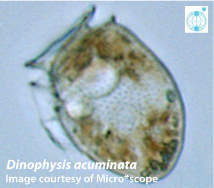The plastid thief
Dinophysis
Plastids are the photosynthetic organelle of plants and algae and are of critical importance (directly or indirectly) to most organisms. The first plastid was derived from endosymbiotic cyanobacteria within an ancestral eukaryote. The antiquity of the first endosymbiotic event makes it difficult to study, and not much is known about the process of plastid acquisition or the extent that gene transfer has shaped the evolutionary history of plastids and their hosts. Dinoflagellates are model organisms for the study of plastid evolution as they have undergone more recent plastid replacements through secondary and even tertiary endosymbiosis. Within dinoflagellates, the genus Dinophysis is of particular interest. Dinophysis acquires its plastid through kleptoplastidy, the temporary retention of functional plastids from photosynthetic prey. Kleptoplasts survive within the host for a short time (days to weeks). However, Dinophysis plastids are found within the cytoplasm, not inside food vacuoles, and can be maintained within the cell for several months. Dinophysis plastids are derived from the cryptophyte Geminigera cryophila. The cryptophyte plastid is surrounded by four membranes and contains a nucleomorph (the remnant of the red algal endosymbiont nucleus containing genes required for plastid maintenance). When Dinophysis acquires the cryptophyte plastid, the nucleomorph and two outer membranes of the plastid are not retained.
Key aspects of Dinophysis physiology, toxicity, and genetics have remained intractable due to the inability to grow and maintain these organisms in laboratory cultures. Dependable culturing methods are now established following the discovery that Dinophysis obtains its plastid through a ciliate intermediate. Dinophysis and the nature of its plastid can finally be investigated.